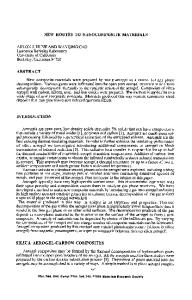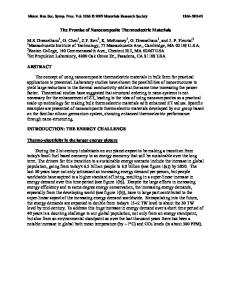Characterization of Dendrimer-Gold Nanocomposite Materials
- PDF / 280,934 Bytes
- 6 Pages / 612 x 792 pts (letter) Page_size
- 32 Downloads / 333 Views
EE13.33.1
Characterization of Dendrimer-Gold Nanocomposite Materials Lajos P. Balogh,* T. Rose Ganser, Xiangyang Shi Center for Biologic Nanotechnology, University of Michigan, Ann Arbor, MI 48109-0533 ABSTRACT Gold-dendrimer nanocomposite materials have various applications in catalysis, optics, biological sensing, cancer therapeutics, as well as building blocks to assemble functional films. Primary amine-terminated poly(amidoamine) (PAMAM) dendrimers of different generations (generation 2 through 6) were used as templates to synthesize gold-dendrimer hybrid nanocomposites. UV-Vis spectrometry, fluorescence, transmission electron microscope (TEM), zeta-potential, and polyacrylamide gel electrophoresis (PAGE) were used to extensively characterize these nanocomposite materials. Results indicate that the structure of gold-dendrimer nanocomposites changes as the function of generation and their size decreases with the increase of the generation number of dendrimer templates. TEM shows that aggregated gold-dendrimer nanocomposites are polycrystalline. These nanocomposites are fluorescent and display a stronger emission intensity (458 nm) than commercially available gold nanoparticles of similar size do. PAGE analysis shows that the gold-dendrimer nanocomposites have electrophoretic migration patterns that are similar to those of the corresponding dendrimer templates. The combination of applied different analytical techniques provides new insights into the structure and properties of gold-dendrimer nanocomposite materials.
INTRODUCTION Poly(amidoamine) (PAMAM) dendrimers are spherical, highly branched macromolecules that have a tree-like branching structure with symmetrically emanating dendrons of defined molecular weight and size. They are composed of a core molecule, dendritic branches that regularly extend from the core, and terminal groups [1]. PAMAMs are macromolecules with a narrow polydispersity and are ideal templates for nanocomposite synthesis due to their “built-in” functional groups, fairly uniform composition and defined structure. Dendrimer nanocomposites (DNC) are organic/inorganic hybrid materials in which the inorganic and organic phases are mixed at the molecular/atomic level without having covalent bonds between host(s) and guest(s). Several groups pioneered the research on gold-dendrimer nanocomposites [2-6]. Although extensive studies have been performed regarding their synthesis, characterization, and potential applications, there are few reports related to the generation-dependent structure and properties of gold-dendrimer nanocomposites. In this work, we selected primary amine-terminated PAMAMs of generation 2 through 6 as templates to synthesize gold-dendrimer nanocomposite particles with consistent molar ratio of dendrimer nitrogen ligands and gold atoms. Various *
To whom correspondence should be addressed. 4010 Kresge Research Building II, 200 Zina Pitcher Place, Ann Arbor, MI 48109-0533E-mail:[email protected] Tel.: (734) 615-0623; Fax: (734) 615-0621
EE13.33.2
characterization techniqu
Data Loading...











